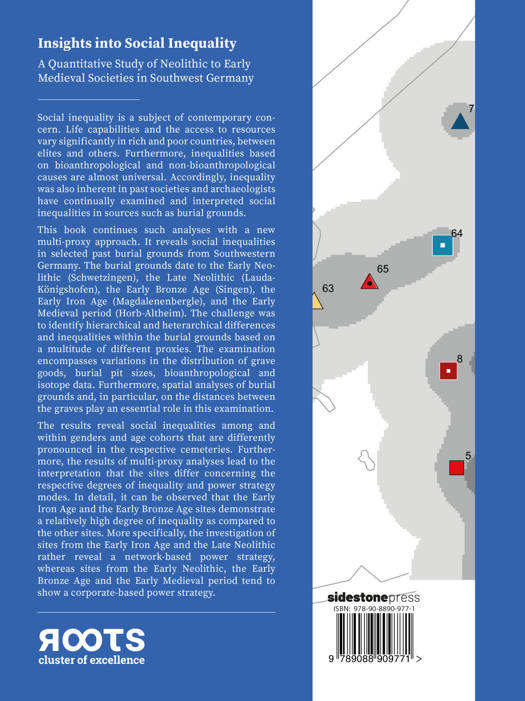
- Retrait gratuit dans votre magasin Club
- 7.000.000 titres dans notre catalogue
- Payer en toute sécurité
- Toujours un magasin près de chez vous
- Retrait gratuit dans votre magasin Club
- 7.000.0000 titres dans notre catalogue
- Payer en toute sécurité
- Toujours un magasin près de chez vous


Insights Into Social Inequality
A Quantitative Study of Neolithic to Early Medieval Societies in Southwest Germany
Ralph Grossmann
135,00 €
+ 270 points
Format
Description
Social inequality is a subject of contemporary concerns. Life capabilities and the access to resources vary significantly in rich and poor countries, between elites and others. Furthermore, inequalities based on bio-anthropological and non-bio-anthropological causes are almost universal. Accordingly, inequality was also inherent in past societies and archaeologists have continually examined and interpreted social inequalities in sources such as burial grounds.
This book continues such analyses with a new multi-proxy approach. It reveals social inequalities in selected past burial grounds from Southwestern Germany. The burial grounds date to the Early Neolithic (Schwetzingen), the Late Neolithic (Lauda-Königshofen), the Early Bronze Age (Singen), the Early Iron Age (Magdalenenbergle), and the Early Medieval period (Horb-Altheim). The challenge was to identify hierarchical and heterarchical differences and inequalities within the burial grounds based on a multitude of different proxies. The examination encompasses variations in the distribution of grave goods, burial pit sizes, bio-anthropological and isotope data. Furthermore, spatial analyses of burial grounds and, in particular, on the distances between the graves play an essential role in this examination.
The results reveal social inequalities among and within genders and age cohorts that are differently pronounced in the respective cemeteries. Furthermore, the results of multi-proxy analyses lead to the interpretation that the sites differ concerning the respective degrees of inequality and power strategy modes. In detail, it can be observed that the Early Iron Age and the Early Bronze Age sites demonstrate a relatively high degree of inequality as compared to the other sites. More specifically, the investigation of sites from the Early Iron Age and the Late Neolithic rather reveal a network-based power strategy, whereas sites from the Early Neolithic, the Early Bronze Age and the Early Medieval period tend to show a corporate-based power strategy.
This book continues such analyses with a new multi-proxy approach. It reveals social inequalities in selected past burial grounds from Southwestern Germany. The burial grounds date to the Early Neolithic (Schwetzingen), the Late Neolithic (Lauda-Königshofen), the Early Bronze Age (Singen), the Early Iron Age (Magdalenenbergle), and the Early Medieval period (Horb-Altheim). The challenge was to identify hierarchical and heterarchical differences and inequalities within the burial grounds based on a multitude of different proxies. The examination encompasses variations in the distribution of grave goods, burial pit sizes, bio-anthropological and isotope data. Furthermore, spatial analyses of burial grounds and, in particular, on the distances between the graves play an essential role in this examination.
The results reveal social inequalities among and within genders and age cohorts that are differently pronounced in the respective cemeteries. Furthermore, the results of multi-proxy analyses lead to the interpretation that the sites differ concerning the respective degrees of inequality and power strategy modes. In detail, it can be observed that the Early Iron Age and the Early Bronze Age sites demonstrate a relatively high degree of inequality as compared to the other sites. More specifically, the investigation of sites from the Early Iron Age and the Late Neolithic rather reveal a network-based power strategy, whereas sites from the Early Neolithic, the Early Bronze Age and the Early Medieval period tend to show a corporate-based power strategy.
Spécifications
Parties prenantes
- Auteur(s) :
- Editeur:
Contenu
- Nombre de pages :
- 236
- Langue:
- Anglais
- Collection :
- Illustré:
- Oui
Caractéristiques
- EAN:
- 9789088909788
- Date de parution :
- 24-06-21
- Format:
- Livre relié
- Format numérique:
- Genaaid
- Dimensions :
- 210 mm x 279 mm
- Poids :
- 1055 g

Les avis
Nous publions uniquement les avis qui respectent les conditions requises. Consultez nos conditions pour les avis.







